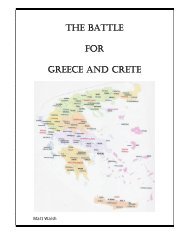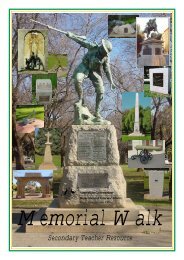Eastern Adelaide Teacher resource.pdf - Army Museum of South ...
Eastern Adelaide Teacher resource.pdf - Army Museum of South ...
Eastern Adelaide Teacher resource.pdf - Army Museum of South ...
You also want an ePaper? Increase the reach of your titles
YUMPU automatically turns print PDFs into web optimized ePapers that Google loves.
Memorial Kensington and Norwood War Trophies (cannons)<br />
Address Osmond Terrace, Norwood<br />
Background Information<br />
War trophies are captured objects that<br />
have been taken from the battlefield.<br />
The history <strong>of</strong> claiming trophies or<br />
spoils <strong>of</strong> war from defeated enemies<br />
dates back thousands <strong>of</strong> years. During<br />
World War I, trophies captured by the<br />
Allies were specially marked with a tag<br />
which included the name <strong>of</strong> the unit that<br />
captured the piece and the date and time.<br />
Soldiers carried these labels into battle<br />
ready to tag captured items according to<br />
War Office regulations. During World<br />
War I, Australian troops captured large numbers <strong>of</strong> guns <strong>of</strong> all types. The ground<br />
taken and consequently the trophies claimed by Australian soldiers far exceeded the<br />
comparative size <strong>of</strong> our contribution to the allied forces on the Western Front. Many<br />
items were acquired including rifles, trench mortars, machine guns and various<br />
artillery pieces, including one large gun, the Amiens Gun, which was mounted on a<br />
railway carriage at Harbonnieres, France. After the war, items such as the Amiens<br />
Gun were transported back to Australia. Under the Australian War Trophies Act <strong>of</strong><br />
1919, communities were allocated these trophies in recognition <strong>of</strong> their contribution<br />
to Australia's war effort.<br />
In addition to <strong>of</strong>ficial war trophies claimed by the government individual soldiers also<br />
brought back other items <strong>of</strong> memorabilia from the Boer War and subsequent conflicts.<br />
These were <strong>of</strong>ten easily carried items, some <strong>of</strong> which were obtained from enemy<br />
soldiers. Some <strong>of</strong> these had personal or cultural significance to the original owners<br />
and their relatives. A small number <strong>of</strong> these items, mostly acquired during the Second<br />
World War, have been returned to thankful relatives over recent years. However, the<br />
great majority <strong>of</strong> Australia’s wartime memorabilia remains in private hands with some<br />
forming part <strong>of</strong> displays in local Returned and Services League (RSL) halls. The term<br />
wartime memorabilia includes a wide range <strong>of</strong> objects and material. Common items<br />
include wartime diaries, swords, flags, letters, badges, postcards, buttons, weapons,<br />
uniforms, hats and helmets, ration cards, medals, weapons, ammunition and trench art.<br />
Student Activities<br />
On Site<br />
(1) The war trophy (large gun) which is located closest to the Kensington and<br />
Norwood Soldiers’ Memorial was captured by the Australian Light Horse<br />
in the Middle East during World War I. It is a World War I howitzer.<br />
What is the number <strong>of</strong> the gun, its German maker and the year <strong>of</strong><br />
manufacture <strong>of</strong> this gun? Hint: Check the back <strong>of</strong> the breech.<br />
25











